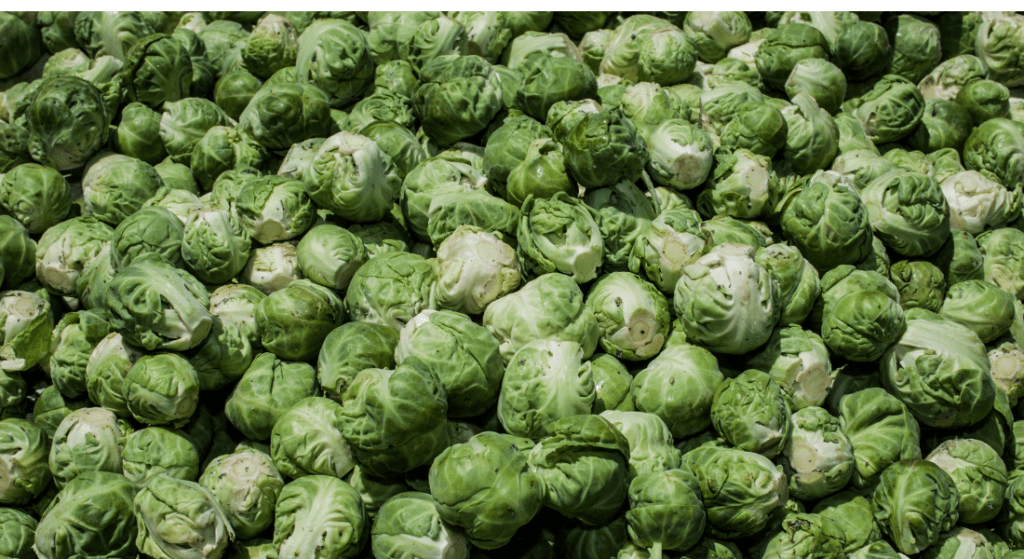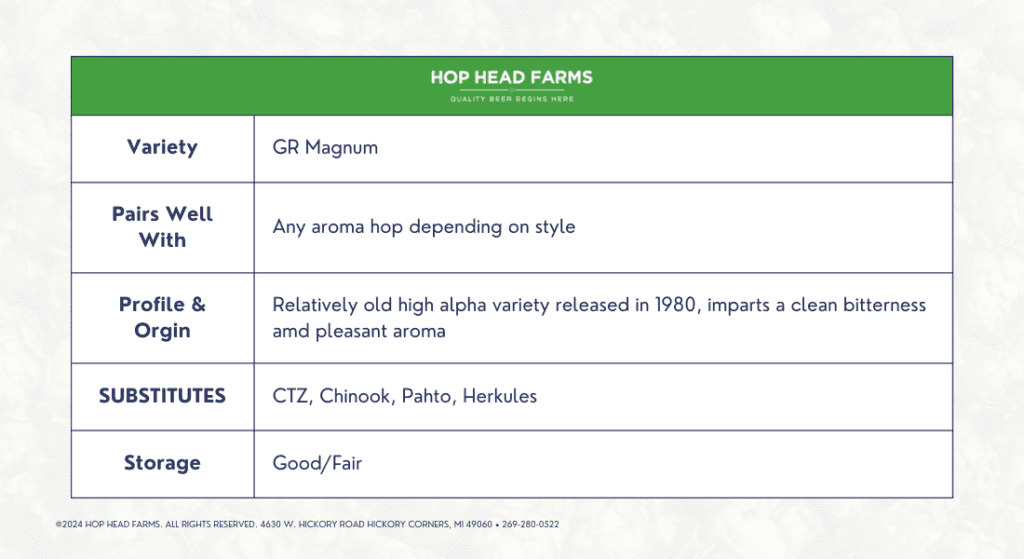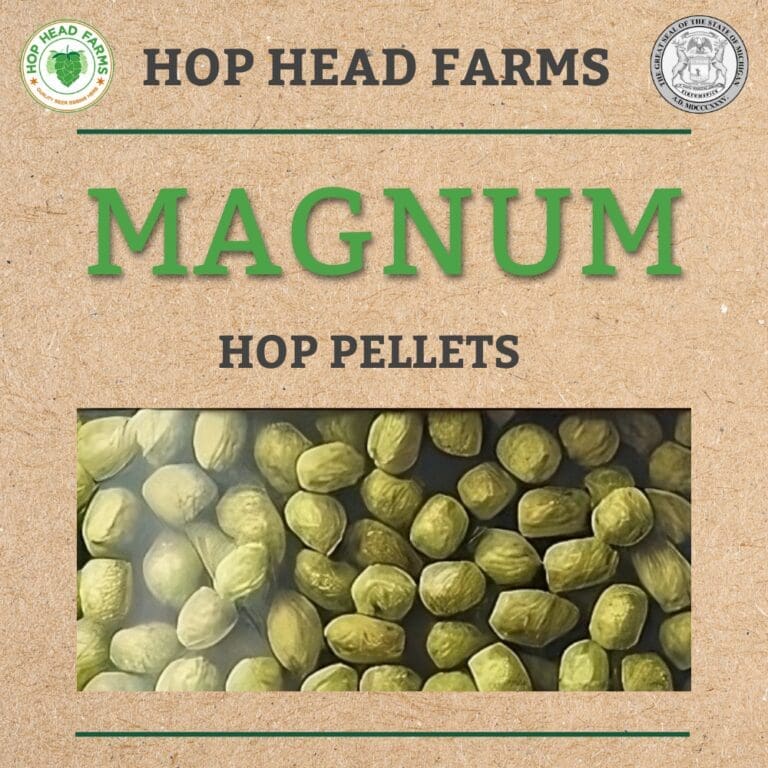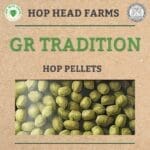If you’re a homebrewer or even just a beer enthusiast, you’ve likely heard of Magnum hops. These versatile cones have made a significant impact on the brewing world, particularly in the realm of bittering. But what exactly makes Magnum hops so special? How do they differ from other hop varieties, and how can you harness their power to enhance your brews? In this comprehensive guide, we’ll delve deep into the world of Magnum hops, exploring their origins, characteristics, and brewing applications. Whether you’re a seasoned brewmaster or just dipping your toes into the world of homebrewing, this article is your ultimate companion to unlocking the full potential of Magnum hops.

Introduction to Magnum Hops
Magnum hops have become a cornerstone in the toolkit of brewers worldwide, renowned for their unique characteristics and versatile applications in brewing. Understanding the intricacies of this beer hops is essential for any brewer looking to craft exceptional beers consistently. In this section, we’ll provide a brief overview of Magnum hops and discuss why grasping their characteristics is crucial for brewing success.
Magnum hops, also known as Hallertauer Magnum, are a high alpha acid variety of hop that has gained prominence since its inception. These hops are celebrated for their ability to impart clean bitterness and subtle flavors to a wide range of beer styles. However, unlocking the full potential of Magnum hops requires a deeper understanding of their origins, history, and inherent qualities.
Origins and History of Magnum Hops
The story of Magnum hops begins in 1980 at the Hop Research Center in Hüll, Germany. It was here that Magnum hops were bred, a result of careful experimentation and selective breeding. Magnum hops are the offspring of Galena, a well-known American hop variety, and a German male hop, blending the best of both worlds in terms of flavor and aroma.
This unique parentage gives Magnum hops their distinctive character, setting them apart from other hop varieties. Over the years, Magnum hops have garnered acclaim for their consistency, reliability, and exceptional brewing qualities, earning them a permanent place in the pantheon of brewing ingredients.
Characteristics of Magnum Hops
At the heart of Magnum hops lie several defining characteristics that make them a favorite among brewers worldwide. One of the most notable attributes of Magnum hops is their high alpha acid content, typically ranging from 11.0% to 16.0%. This high alpha acid content makes Magnum hops ideal for bittering additions, allowing brewers to achieve the desired level of bitterness without excessive hop usage.
In addition to their high alpha acid content, Magnum hops are prized for their clean bitterness and smooth flavor profile. When used as a bittering hop, Magnum hops impart a crisp, refreshing bitterness to beer, providing a solid foundation for building complex flavor profiles.
Furthermore, Magnum hops exhibit subtle floral and citrus notes, adding depth and complexity to the finished brew without overpowering other ingredients.

Brewing Applications of Magnum Hops
Magnum hops offer a wide range of brewing applications, making them a versatile choice for brewers of all levels. In this section, we’ll explore the primary uses of Magnum hops and discuss how they can be incorporated into different beer styles to achieve desired flavors and aromas.
Primary Use as a Bittering Hop
One of the primary applications of Magnum hops is as a bittering agent in brewing. Due to their high alpha acid content and clean bitterness, Magnum hops are often added early in the boil to extract maximum bitterness from the hops while minimizing any undesirable flavors. This makes Magnum hops an excellent choice for beers that require a pronounced bitterness, such as IPAs, stouts, and pale ales.
Incorporating Magnum Hops in Different Beer Styles
While Magnum hops are commonly used for bittering, they can also be utilized in a variety of beer styles to impart unique flavors and aromas. For example, Magnum hops can be added late in the boil or during dry hopping to contribute subtle floral and citrus notes to lighter beer styles such as lagers and wheat beers. Additionally, Magnum hops can be used in combination with other hop varieties to create complex flavor profiles in more hop-forward styles like IPAs and double IPAs.
Utilizing Magnum Hop Pellets for Consistent Bitterness
Magnum hops are often available in pellet form, which offers brewers a convenient and consistent way to add bitterness to their brews. When using Magnum hop pellets, brewers can accurately calculate hop additions based on the alpha acid content of the pellets, ensuring consistent bitterness from batch to batch. Additionally, hop pellets are easy to store and measure, making them a practical choice for brewers of all experience levels.
Optimizing Hop Utilization with Magnum Hops
To fully harness the potential of Magnum hops, brewers must optimize their hop utilization during the brewing process. In this section, we’ll explore best practices for maximizing the bitterness and flavor extraction from Magnum hops to create exceptional beers.
Calculating Hop Additions Based on Alpha Acid Content
When using Magnum hops in brewing, it’s essential to calculate hop additions based on the alpha acid content of the hops. By knowing the alpha acid percentage of the hops, brewers can determine the appropriate amount of hops needed to achieve the desired level of bitterness in their beer. This ensures that brewers can achieve consistent results with each batch of beer they brew.
Maximizing Bitterness Extraction During the Boil
To maximize bitterness extraction from Magnum hops during the boil, brewers should add the hops early in the brewing process. Boiling Magnum hops for an extended period allows for the efficient extraction of alpha acids, resulting in a clean and pronounced bitterness in the finished beer. Additionally, ensuring vigorous boiling conditions helps to release the desired bitterness from the hops and distribute it evenly throughout the beer.
Tips for Using Magnum Hops in Aroma Additions
While Magnum hops are primarily known for their bittering properties, they can also contribute subtle aroma characteristics when added late in the brewing process or during dry hopping. When using Magnum hops for aroma additions, brewers should be mindful of their high alpha acid content and use them sparingly to avoid overpowering the beer’s other flavors. Additionally, experimenting with different hopping techniques and hop combinations can help brewers achieve the desired aroma profile in their beer.
Experimentation with Magnum Hops
One of the most exciting aspects of brewing with Magnum hops is the opportunity for experimentation. In this section, we’ll explore different brewing techniques, recipes, and creative ways to incorporate Magnum hops into your brewing repertoire.
Exploring Different Brewing Techniques
Brewers can experiment with various brewing techniques to showcase the unique characteristics of Magnum hops. For example, adjusting the timing and quantity of Magnum hop additions can influence the beer’s bitterness, flavor, and aroma profile. Additionally, exploring different hopping methods, such as hop bursting or hop stands, can highlight specific qualities of Magnum hops and create distinct beer experiences.
Recipes and Styles that Showcase Magnum Hops
Magnum hops can be used in a wide range of beer styles, from traditional lagers to hop-forward IPAs and everything in between. Experimenting with Magnum hops in different recipes allows brewers to explore the full spectrum of flavors and aromas that these versatile hops have to offer. Whether brewing a classic pilsner, a robust stout, or a tropical IPA, Magnum hops can add depth and complexity to any beer style.
Creative Ways to Incorporate Magnum Hops in Brewing
In addition to traditional brewing methods, brewers can get creative with how they incorporate Magnum hops into their recipes. For example, Magnum hops can be used in combination with other hop varieties to create unique flavor combinations and profiles. Additionally, brewers can experiment with hop blends, hop teas, and hop extracts to extract specific flavors and aromas from Magnum hops and customize their brews to their liking.
Advantages of Using Magnum Hops
Magnum hops offer brewers several advantages that make them a preferred choice for many brewing applications. In this section, we’ll explore the benefits of using Magnum hops and discuss why they are a valuable addition to any brewer’s arsenal.
High Alpha Acid Content for Efficient Bittering
One of the primary advantages of Magnum hops is their high alpha acid content, which makes them an efficient and effective bittering agent in brewing. The high alpha acid content of Magnum hops allows brewers to achieve the desired level of bitterness in their beer while minimizing the quantity of hops needed. This not only saves on costs but also reduces the risk of introducing undesirable flavors from excessive hop additions.
Good Yields and Disease Resistance
Magnum hops are known for their robust growth characteristics, including good yields and disease resistance. This makes them a reliable and low-maintenance crop for hop growers, ensuring a steady supply of high-quality hops for brewers. Additionally, Magnum hops thrive in a variety of growing conditions, making them suitable for cultivation in a wide range of regions around the world.
Versatility in Brewing Various Beer Styles
Perhaps one of the most significant advantages of Magnum hops is their versatility in brewing various beer styles. From light and crisp lagers to bold and hoppy IPAs, Magnum hops can be used to create a wide range of beer styles with distinct flavor profiles. Whether used as a primary bittering hop or for aroma additions, Magnum hops offer brewers unparalleled flexibility and control over the brewing process.
Considerations for Brewing with Magnum Hops
When brewing with Magnum hops, it’s essential to consider several factors to ensure the best possible outcome for your beer. In this section, we’ll explore some key considerations for using Magnum hops in your brewing recipes.
Avoiding Overuse to Maintain Balance
While Magnum hops are prized for their clean bitterness, it’s crucial to avoid overusing them in your recipes. Excessive bitterness can overpower other flavors in the beer, leading to an unbalanced and unpleasant drinking experience. Be mindful of the alpha acid content of Magnum hops and use them judiciously to achieve the desired level of bitterness without overwhelming the beer’s other characteristics.
Impact on Overall Flavor Profile
In addition to bitterness, Magnum hops can contribute subtle flavor and aroma characteristics to your beer. When incorporating Magnum hops into your recipes, consider how their flavor profile will complement the other ingredients in the beer. Experiment with different hopping techniques and hop combinations to achieve the perfect balance of flavors and aromas in your brew.
Best Practices for Incorporating Magnum Hops in Recipes
To get the most out of Magnum hops in your brewing recipes, it’s essential to follow some best practices. When using Magnum hops as a bittering hop, add them early in the boil to maximize bitterness extraction while minimizing aroma contribution. For aroma additions, consider adding Magnum hops late in the boil or during dry hopping to preserve their subtle floral and citrus notes. Additionally, be sure to calculate hop additions accurately based on the alpha acid content of the hops to achieve consistent results with each batch of beer you brew.
Magnum Hops in Homebrewing
For homebrewers, Magnum hops offer a world of possibilities for crafting delicious beers in the comfort of your own home. In this section, we’ll explore some tips and resources for homebrewers looking to incorporate Magnum hops into their brewing repertoire.
Tips for Homebrewers Using Magnum Hops
When brewing with Magnum hops at home, start by experimenting with small batches to familiarize yourself with their characteristics and how they interact with other ingredients. Be sure to calculate hop additions accurately based on the alpha acid content of the hops to achieve the desired level of bitterness in your beer. Additionally, don’t be afraid to get creative and try new brewing techniques to showcase the unique qualities of Magnum hops in your homebrews.
Availability and Sourcing of Magnum Hops for Homebrewing
At Hop Head Farms, we understand the importance of sourcing high-quality hops for your homebrewing endeavors. That’s why we’re proud to offer a wide selection of Magnum hops, available in both whole leaf and pellet form, to homebrewers around the world. Whether you’re brewing a hop-forward IPA or a classic lager, you can rely on Hop Head Farms to provide you with the Magnum hops you need to elevate your homebrewing experience. Buy hops at our website today to explore our selection and start brewing your best beer yet!
Recipes and Resources for Brewing with Magnum Hops at Home
For homebrewers looking for inspiration, there are plenty of recipes and resources available for brewing with Magnum hops. Many homebrewing websites and forums feature recipes submitted by fellow homebrewers, offering a wealth of ideas for incorporating Magnum hops into your brewing repertoire. Additionally, there are numerous books and online resources available that guide brewing techniques and recipe formulation, helping you make the most of your Magnum hops in your homebrews.
Conclusion: Harnessing the Power of Magnum Hops
In conclusion, Magnum hops are a versatile and valuable ingredient in the brewing world, offering brewers of all levels the opportunity to craft exceptional beers with clean bitterness and subtle flavors. By understanding the characteristics of Magnum hops and following best practices for incorporating them into your brewing recipes, you can unlock their full potential and create beers that delight the palate. So go ahead, experiment, and explore the world of Magnum hops in brewing, and discover the endless possibilities they offer for creating unique and flavorful beers at home and beyond.






